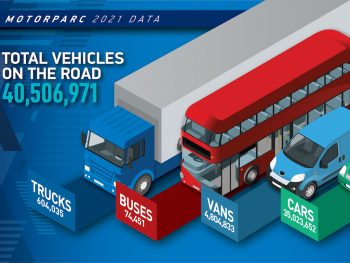Electric vehicle use rises by 71% but car ownership falls
The number of electric vehicles on UK roads has soared but car ownership has seen its second-ever fall in more than 100 years.

The number of vehicles on UK roads increased 0.4%, but car ownership has fallen 0.2% – the first consecutive annual decrease in car ownership in more than 100 years
New data from the Society of Motor Manufacturers and Traders (SMMT) shows that nearly three-quarters of a million vehicles on the road today are plug-ins. This includes 720,053 cars, 26,990 vans, 993 buses and 313 trucks.
Overall, the number of vehicles in the UK grew 0.4% to 40,506,971 in 2021, but car ownership itself fell 0.2% to 35,023,652 vehicles – it’s the second year in a row that the car parc has fallen and the first time the UK has experienced consecutive falls in more than a century.
The SMMT said the fall was largely the result of the pandemic and related market issues. It also noted that the semiconductor shortage has seen consumers hang onto vehicles for longer. As a result, the average car age has hit a record high of 8.7 years, more than a year older than that of a decade ago.
And this means around 8.4 million cars – just under a quarter of those on the road – today are more than 13 years old, bringing maintenance and road risk issues.
The automotive trade body added that a widespread move to newer, greener vehicles was essential for net zero targets and said that building consumer confidence in the economy and driver confidence in the charging infrastructure was vital to ensure drivers transition to EVs.
While uptake of plug-in cars is growing rapidly, accounting for around one in five new registrations for the year to date, they still only represent around one in 50 cars on the road. Meanwhile, there are some 20.5 million petrol cars and 13 million diesels, making up 58.6% and 37.1% of the car parc respectively, a combined total of 95.7%.
The commercial vehicle sector lags further behind still – some 0.6% of vans on UK roads are now plug-in electric, indicating that the van sector is around two years behind that of cars and with a long way to go to meet the 2030 ICE end-of-sale date. And while 1.3% of buses and coaches are now battery electric, electric trucks account for less than 0.1% of the HGV parc, as the development of unique zero-emission technology for these vehicles continues.
While vehicle developments are vital to meeting targets, the SMMT continues to call for developments in the charging infrastructure to support driver and business confidence to go electric.
It said last week that a national ‘van plan’ for charging was essential to accelerate electric van uptake and to deliver ambitious government targets. Analysis by the association shows the UK has just one public charge point available for every 32 plug-in vehicles on the road – and it’s also pointed out that public charge points designed for cars will not always be suitable or in the right locations for vans, which also typically need a larger parking area.
The SMMT research also found:
- The total parc has increased by 4.7 million vehicles (+13.3%) since 2012.
- The supermini and lower medium car segments account for nearly six in 10 cars in service, at 11,574,902 and 9,209,201 units respectively.
- Manual transmission accounted for 68.1% of the car parc.
- 66.6% of all cars on UK roads were made in the EU, while British-built cars account for 15.3%.
- Drivers in London are more likely to own a British car than other UK regions, with 16.8% of cars built in the UK, followed by the East (16.0%) and South East (15.6%).












